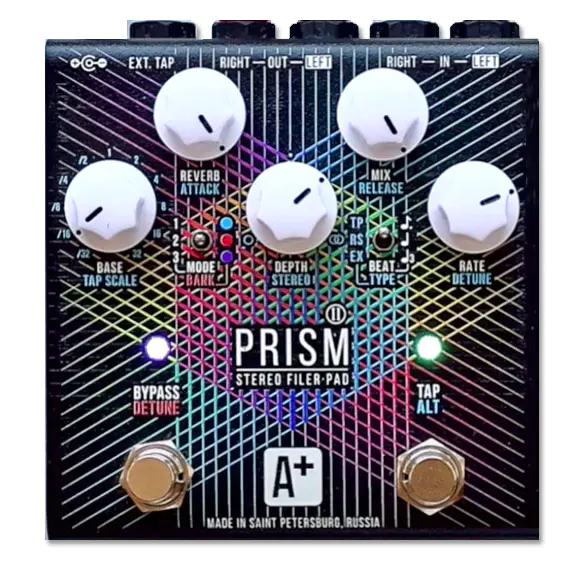
First of all, let us say that this new stereo version of the Prism by Russian builder Shift Line looks rad, and gorgeous-looking devices brighten our day. But that brightness fades in comparison to the blinding beam of creativity it might inspire in the adventurous/unconventional guitarist.
The Prism is a Stereo Filter-Pad that combines elements of subtractive and additive synthesis, reverb, frequency, time and space modulation, in a way that feels “organic” so that they all work together, with each knob simultaneously controlling several parameters.
More specifically, the circuit features
- 1 pitch shifter,
- 4 resonant filters (three types of filtering in each),
- two sections of modulation
- a section of reverb,
- a set of four LFOs to control the stereo field and animate the filter parameters.
Tap tempo can be dialed in through the right footswitch or external link, while the left footswitch can be used for a Detune momentary effect. there’s also a function to simulate the action of an Expression pedal.
Needless to say, it has Preset functionality, optional Tails Mode, Kill Dry function and USB connectivity – among other features.
Hear the celestial sounds of the Shift Line Prism II in the videos below.
Main features of Prism II
- A comprehensive filter pad that is second to none.
- A full-fledged stereo path with the possibility of expanding the mono signal.
- Three modes of operation: tap-tempo, generator restart and expression.
- Tap-tempo with a choice of duration, as well as the ability to slow down or speed up the modulation interval in multiples (from 2 to 32 times).
- The transpose section allows you to add octave intervals (up, down) and fifths to the signal.
- Four resonant filters animated by three LFOs with adjustable range of influence.
- The reverb section between the filter groups allows for both soft pads and rich spatial processing, as well as harmonic tremolo effects on the reverb tail.
- Signal modulation for chorus, vibrato and soft flanging effects. In combination with filter modulation, a phaser can also be obtained.
- 12 programs with a choice of switching type (bank / patch): 9 with direct access, 3 more are available in the configuration file.
- Micro-USB for updates and tweaking.
- The operating mode of the device and each of the programs can be changed by the user in the configuration file.
- Detune Mode – mode for smooth change of the pitch of the transposed signal.
- Favorite function that allows you to save and recall your favorite configuration from the built-in memory.
- Jack for external control of the tap-tempo button using passive controllers, analog triggers (S-trig / V-trig) or MIDI Clock / Play.
- Fully analog clean signal path.
- Enables / disables effect tails in bypass.
- Kill Dry function that eliminates the clean signal from the output and allows the pedal to be used in Wet-Dry-Wet configurations and external mixing systems.
- Small and lightweight aluminum body with connectors located on the top edge for easy switching and layout of the pedalboard.
- Universal power supply in the range from 9 to 12 volts DC and low consumption for digital devices (75-100 mA).
A detailed description of the signal path inside Prism II and the specifics of the interaction of elements can be found below on this page.
A + Prism II – a new generation of Prism-9 complex effect…
The device is built on a combination of several principles of sound processing at once and goes beyond the standard classification.
Prism II features elements of subtractive and additive synthesis, reverb, and frequency, time and space modulation. The elements are not a standard sequence of treatments, but are built into a single “organism” with simultaneous control of several parameters. You can achieve similar results by using a chain of multiple time-synchronized effects. But assembling such a circuit will not be easy, because the Prism II has on board three sections of a pitch shifter, four resonant filters (three types of filtering in each), two sections of modulation and a section of reverb. All this is built into a single circuit, at each stage of which there is a section of the mix to the previous signal. There are two such chains, since the device works in stereo. Moreover, a set of four LFOs allow you to both control the stereo field and animate the filter parameters. The device is time-synchronized by the TAP button or external source. There is also an expression emulation mode and a DETUNE function.
Prism II is a compact inspiration station that replaces an entire box of Eurorack modules. In the world of guitar effects, it’s almost impossible to create such connections in separate treatments, even with an impressive pedalboard.
We were inspired to create this type of processing by the principles applied in the field of sound synthesis. These principles have evolved since the 70s, but are poorly applied outside of studios with a lot of expensive equipment. The effect has no direct analogs and is not limited to adaptation to a specific instrument. It doesn’t matter what input source (guitar, bass, monophonic or polyphonic synthesizer, vocals or drums) – you can safely use it with Prism II.






















